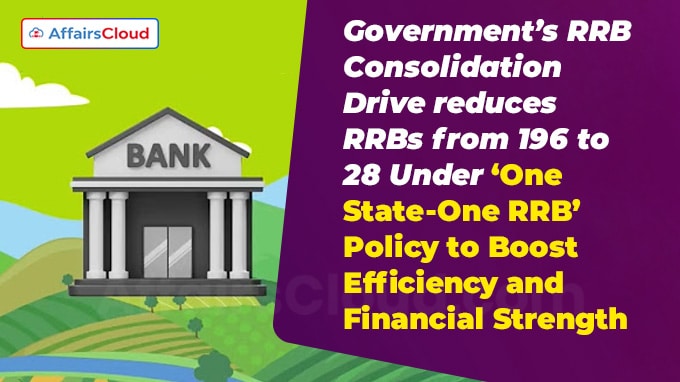 The Government of India (GoI) initiated a structural consolidation of Regional Rural Banks (RRBs) in Financial Year 2005–06 (FY06) to improve their operational viability and harness the benefits of economies of scale.
The Government of India (GoI) initiated a structural consolidation of Regional Rural Banks (RRBs) in Financial Year 2005–06 (FY06) to improve their operational viability and harness the benefits of economies of scale.
- The amalgamation of RRBs has led to the creation of state-level RRBs with contiguous operational areas, streamlining management and enhancing service delivery.
Background:
i.Phase-I amalgamation: In 2005-2010, the number of RRBs was brought down from 196 to 82 by amalgamating RRBs of the same Sponsor Bank within a State.
ii.Phase-II amalgamation: In 2012-14, the number of RRBs was brought down from 82 to 56, by amalgamating RRBs across Sponsor Banks within a State with geographically contiguous areas of operation.
iii.Phase-III amalgamation: Initiated in 2019 by amalgamating weaker RRB with the stronger RRB. The number of RRBs was brought down from 56 to 43 at the end-March 2021.
Key Highlights:
i.In 2021, NABARD (National Bank for Agriculture and Rural Development) conducted a study and found that RRB amalgamation had improved their financial viability and overall performance.
ii.The Reserve Bank of India (RBI) published the findings of the study in their Statutory Publication on ‘Report on Trend and Progress of Banking in India (2020-2021)’.
- The study revealed that across various phases of amalgamation, the share of profitable and sustainably viable RRBs consistently increased, while accumulated losses as a percentage of total assets declined.
- Post-amalgamation profitability, along with capital infusion in weaker banks, led to improvements in both the leverage ratio and the reserves-to-capital ratio of RRBs.
iii.Under Phase-IV of the amalgamation process, the number of RRBs was reduced from 43 to 28, effective from May 1, 2025, across 26 states and 2 Union Territories (UTs).
iv.The amalgamation of RRBs, guided by the ‘One State–One RRB’ principle, was executed based on audited financials as of April 30, 2025, and came into effect on May 1, 2025.
- For smooth implementation, the GoI constituted a State Level Monitoring Committee (SLMC) and a National Level Project Monitoring Unit (NLPMU) to oversee and monitor the amalgamation process.
v.To ensure smooth and structured implementation of the RRB amalgamation process, NABARD issued a comprehensive National-Level Standard Operating Procedure (SOP), outlining detailed steps for policy harmonisation.
- This included the formation of an Amalgamation Project Management Unit (APMU), Steering Committee and Functional Committees to finalise harmonised policies, operational frameworks, and manage the day-to-day integration process.
Note: The “One State-One RRB” principle is a strategic initiative led by the Department of Financial Services (DFS) under the Ministry of Finance (MoF). It aims to reduce the number of RRBs in each state to a single entity, sponsored by a major public sector bank.
About Regional Rural Bank:
The RRBs were established in 1975 under the provisions of the Ordinance promulgated on 26th September 1975 and RRB Act, 1976. The shareholding pattern of RRBs among the Central Government (CG), sponsoring bank and State Government (SG) is 50:35:15 respectively.
The authorised capital of the RRB is Rs 2000 crores. The minimum issued capital of the RRB is Rs 1 crore.




